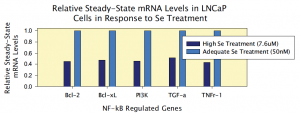Aimee L Taylor and Dr. Merrill J Christensen, Nutrition, Dietetics and Food Science
Introduction
The American Cancer Society estimates that prostate cancer will account for 30% of new cancers in men, totaling over 189,000 new cases, with 30,200 deaths in 2002 (1). Because of its high prevalence and long latency time prostate cancer is an ideal candidate for chemoprevention (2). Recent research suggests an inverse relationship between high dietary selenium (Se) intake or status and risk for prostate cancer. However, the mechanisms for Se’s protective effects against prostate cancer have not yet been determined. This project focused sharply on a single mechanism by which Se may alter gene expression and affect risk for prostate cancer. Demonstration of this mechanism could suggest other interventions, which may be effective in reducing prostate cancer risk by targeting the same processes.
Background Information
Nuclear Factor-kappa B (NF- B) transcription factors are DNA-binding proteins, which regulate expression of genes for pro-inflammatory cytokines, and anti-apoptotic proteins such as Bcl-2, Bcl-xL, Ep-CAM, PI3-K, TGF-á, TNF-á, and TNFr-1 (3). NF- B is constitutively activated in prostate tumor cells. The activation of NF- B and associated increase in anti-apoptotic proteins may be responsible for the resistance of prostate cancer cells to anti-tumor therapy (4,5). Inhibition of NF- B may increase the effectiveness of anti-tumor therapy (6).
Selenium regulates NF- B activity by various mechanisms. At nutritionally adequate levels of Se, selenium-dependent glutathione peroxidase (GPx) enzymes reduce reactive oxygen species that activate NF- B. In cultured cells, stimulation of GPx activity by Se supplementation (7-9) results in inhibition of NF- B activation. At high levels of Se, selenotrisulfide adducts may be formed with cysteine residues in NF- B, which would inhibit its activity (10).
Objectives
The specific aim of this research was to demonstrate that Se alters NF- B-regulated gene expression in human prostate cancer cells. We hypothesized that high levels of selenium would inhibit NF- B activation and the associated expression of various genes linked to carcinogenesis.
Methodology
In order to demonstrate that Se will alter NF- B-regulated gene expression in human prostate cancer cells, cell cultures were prepared using two concentrations of Se (adequate, 50 nM; and high, 7.6 ìM) in the form of methyl seleninic acid. Coding sequences of five NF- B-regulated genes (Bcl-2, Bcl-xL, PI3-K, TGF-á, and TNFr-1) were downloaded from GenBank and imported into a DNA sequence analysis software program (OMIGA) in order to design polymerase chain reaction (PCR) primers that were used to amplify regions of the coding sequences for each gene. Total RNA was isolated from the treated cells using the method of Chomczynski and Sacchi (11) as previously performed in our laboratory. Using the isolated RNA, reverse-transcription reactions were performed to obtain cDNA, which was then used as the DNA template in subsequent real-time PCR reactions. Real-time PCR reactions were performed using a Roche Molecular Biochemicals Light Cycler in order to quantitate steadystate levels of mRNA for each gene.
Results
Steady state mRNA levels were determined for the five NF- B-regulated genes in the adequate Se-treated and high Se-treated cells. We found that steady-state mRNA levels for each of these five genes were reduced by half with high Se treatment as compared to adequate Se treatment as shown in the graph below.
Conclusion
We showed that in the presence of high levels of Se, NF- B-regulated gene expression was reduced. Because Se treatment results in down-regulation of these anti-apoptotic genes, new prostate cancer treatment therapies can be aimed at inhibiting NF- B. This inhibition would cause cells to be more susceptible to apoptosis, and thus would inhibit cancer cell growth. Because we have found that Se inhibits expression of NF- B-regulated genes, we have demonstrated one mechanism by which Se could have a protective effect against prostate cancer. These results will be submitted to the Federation of American Societies for Experimental Biology (FASEB) to be presented at their annual meeting next spring and will be included in a manuscript submitted for publication.
_________________________________________
- American Cancer Society. (2002) Cancer Facts & Figures 2002, http://www.cancer.org/downloads/STT/CancerFacts&Figures2002TM.pdf.
- Schulman, C.C., Zlotta, A.R., Denis, L., Schroder, F.H. & Sakr, W.A. (2000) Prevention of prostate cancer, Scand J Urol Nephrol Suppl, 50-61.
- Heike, P.L. (1999) Activators and target genes of Rel/ NF- B transcription factors, Oncogene 18, 6853-6866.
- Palayoor, S.T., Youmell, M.Y., Calderwood, S.K., Coleman, C.N. & Price, B.D. (1999) Constitutive activation of IkappaB kinase alpha and NF-kappaB in prostate cancer cells is inhibited by ibuprofen, Oncogene 18, 7389-94.
- Sumitomo, M., Tachibana, M., Nakashima, J., Murai, M., Miyajima, A., Kimura, F., Hayakawa, M. & Nakamura, H. (1999) An essential role for nuclear factor kappa B in preventing TNF-alpha-induced cell death in prostate cancer cells, J Urol 161, 674-9.
- Herrmann, J.L., Beham, A.W., Sarkiss, M., Chiao, P.J., Rands, M.T., Bruckheimer, E.M., Brisbay, S. & McDonnell, T.J. (1997) Bcl-2 suppresses apoptosis resulting from disruption of the NF-kappa B survival pathway, Exp Cell Res 237, 101-9.
- Makropoulos, V., Bruning, T. & Schulze Osthoff, K. (1996) Selenium -mediated inhibition of transcription factor NF-kappa B and HIV-1 LTR promoter activity, Arch Toxicol 70, 277-83.
- Sappey, C., Legrand Poels, S., Best Belpomme, M., Favier, A., Rentier, B. & Piette, J. (1994) Stimulation of glutathione peroxidase activity decreases HIV type 1 activation after oxidative stress, AIDS Res Hum Retroviruses 10, 1451-61.
- Tolando, R., Jovanovic, A., Brigeliu-Flohe, R., Ursini, F. & Maiorino, M. (2000) Reactive oxygen species and proinflammatory cytokine signaling in endothelial cells: effect of selenium supplementation, Free Radic Biol Med 28, 979-86.
- Kim, I.Y. & Stadtman, T.C. (1997) Inhibition of NF-kappaB DNA binding and nitric oxide induction in human T cells and lung adenocarcinoma cells by selenite treatment, Proc Natl Acad Sci USA 94, 12904-7.
- Chomczynski, P. & Sacchi, N. (1987) Single -step method of RNA isolation by acid guanidinium thiocyanate -phenol-cholorform extraction, Anal Biochem 162, 156-9.

